Abstract
Multiple skin testing with mycobacterial antigenic preparations reveals distinct reaction patterns, which might be relevant to the development of mycobacterial disease in man. Previous work has shown that HLA-DR associated factors correlate with the position of a leprosy patient in the immunopathological spectrum of leprosy. This study was undertaken to see whether these skin test patterns in healthy persons do show any association with HLA-DR types. Out of a group of 74 healthy Caucasoid individuals HLA-DR3 was observed to be absent from the 16 individuals who did not respond to any of the mycobacterial antigens tested. This is a striking difference from the distribution of HLA-DR3 both among the 17 individuals who responded to all mycobacterial antigens tested (P = 0.005) and the 41 individuals who responded to some but not all antigens (P = 0.015). These data show that an HLA-DR3 associated genetic factor controls, albeit indirectly, skin test responsiveness to mycobacterial antigens. It may be significant that this same HLA-DR determinant is implicated in deciding the type of disease to be developed by a leprosy patient.
Full text
PDF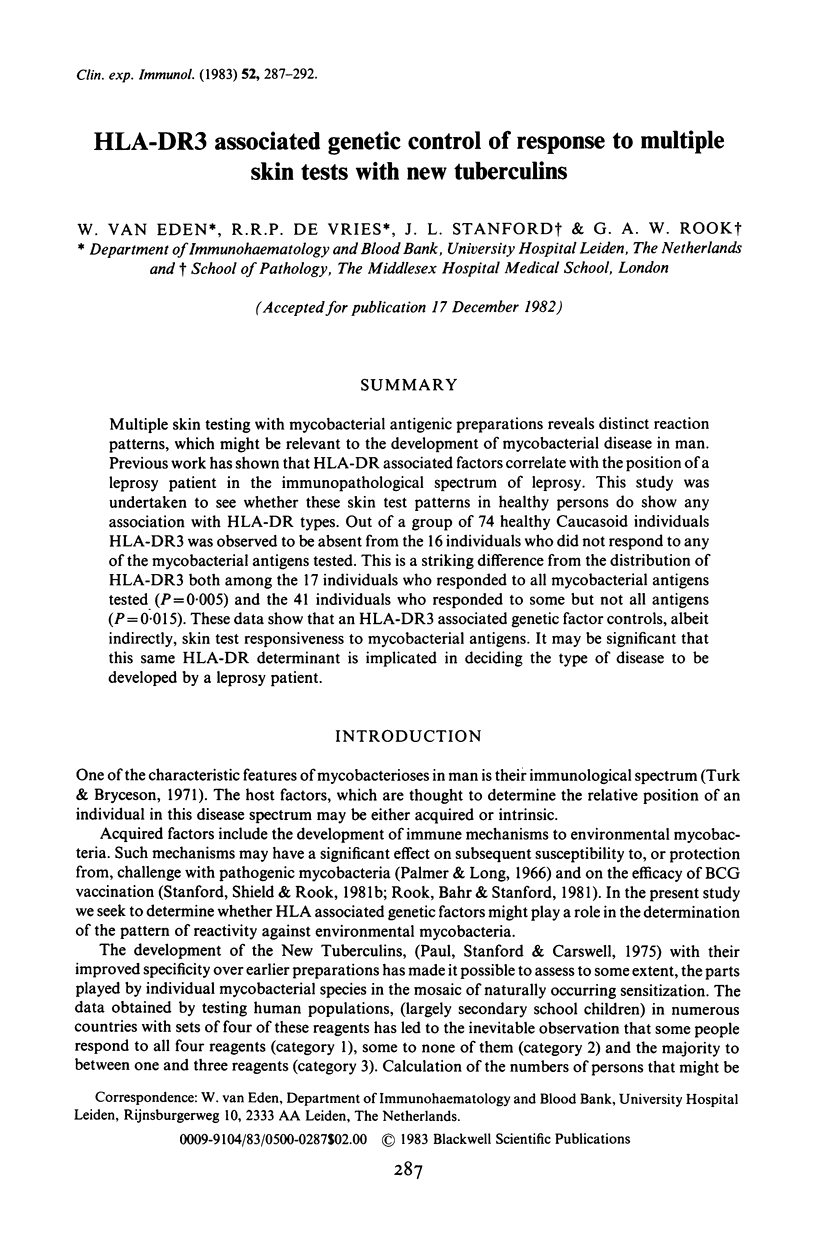
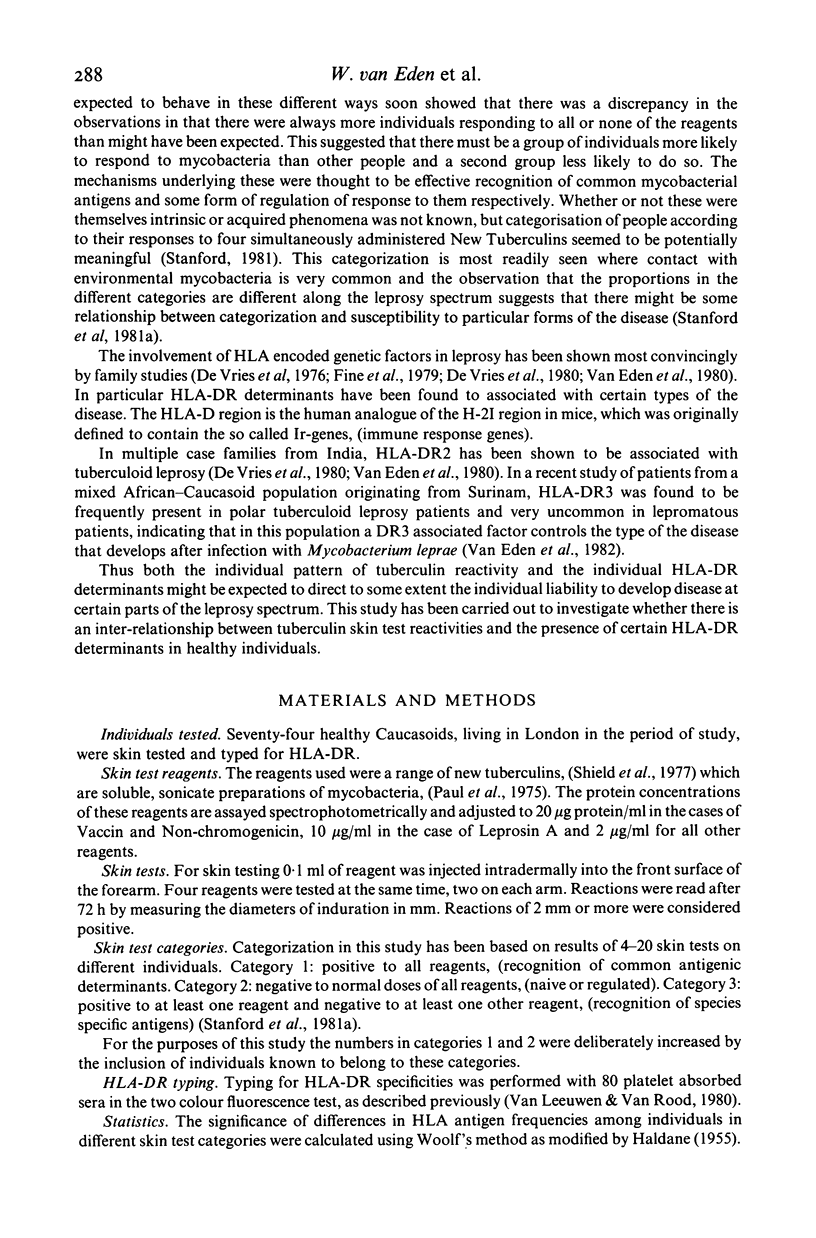
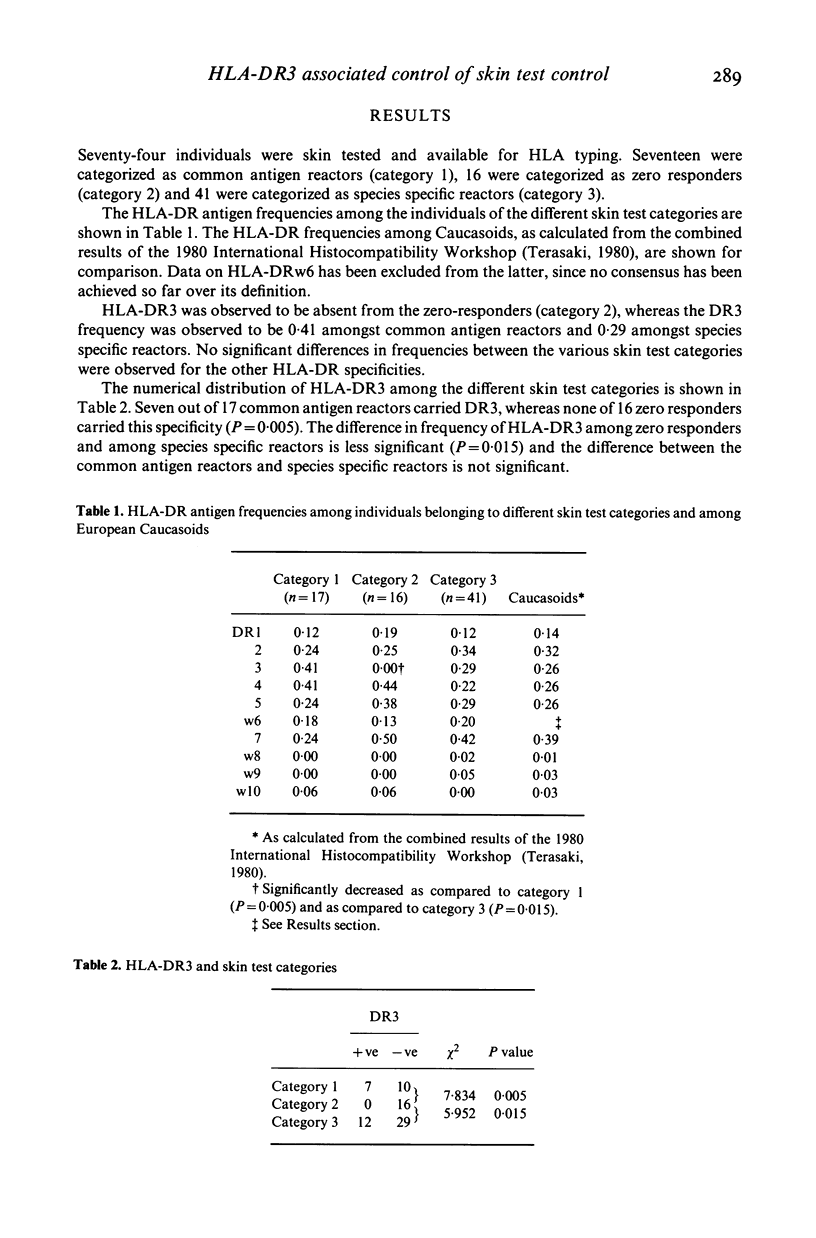
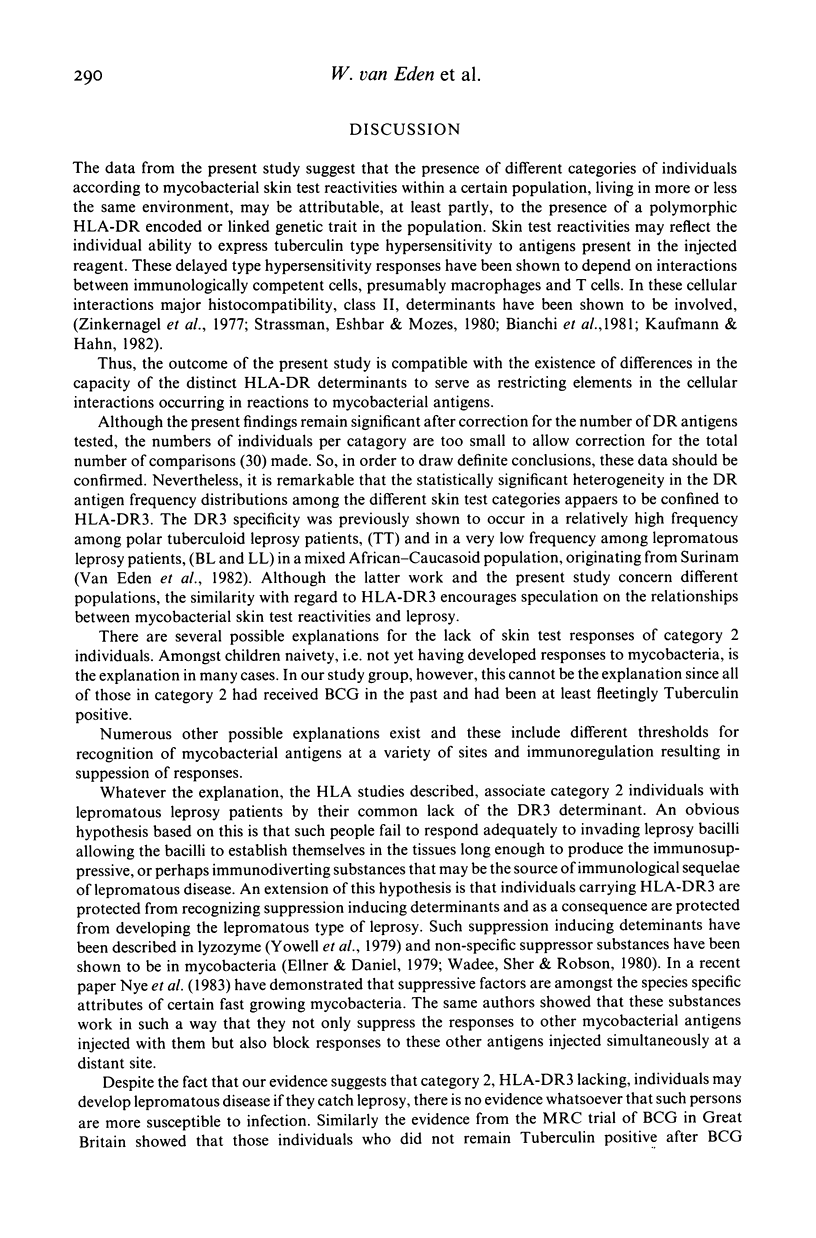
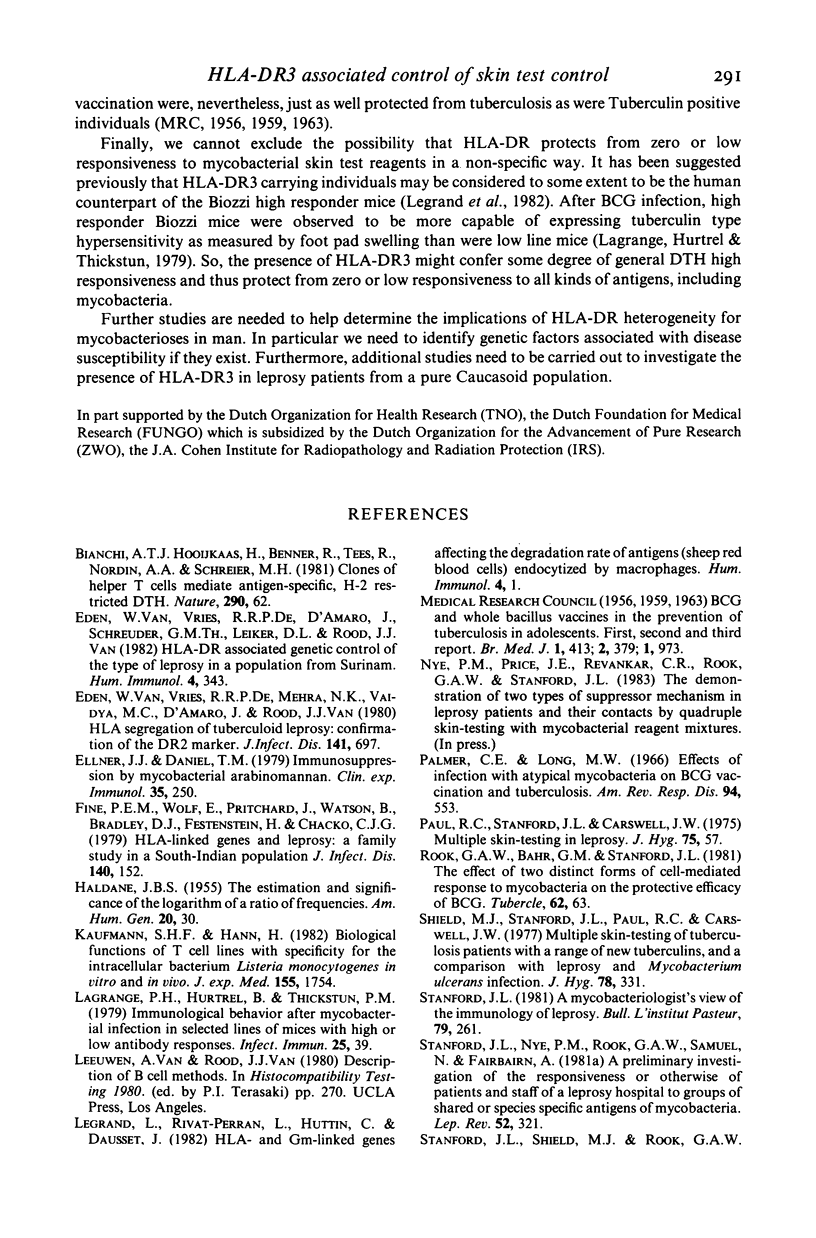
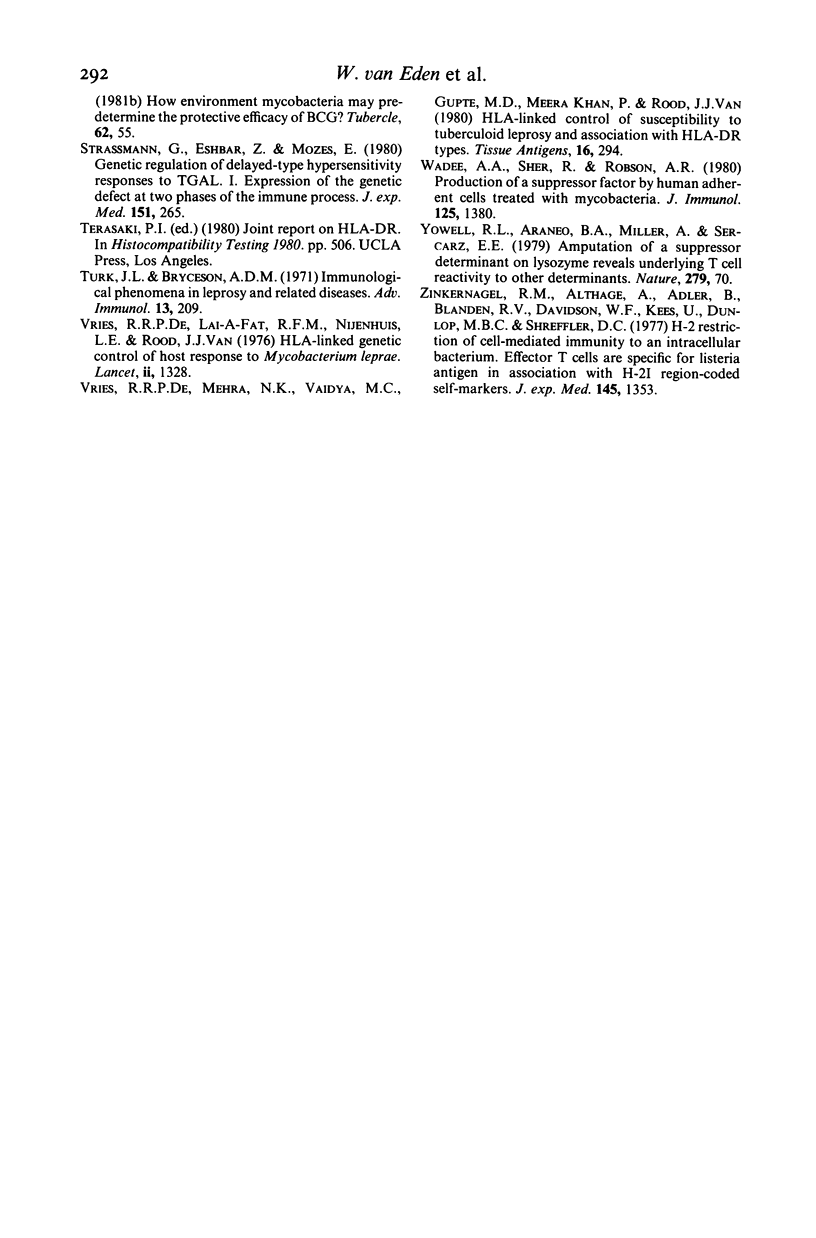
Selected References
These references are in PubMed. This may not be the complete list of references from this article.
- Bianchi A. T., Hooijkaas H., Benner R., Tees R., Nordin A. A., Schreier M. H. Clones of helper T cells mediate antigen-specific, H-2-restricted DTH. Nature. 1981 Mar 5;290(5801):62–63. doi: 10.1038/290062a0. [DOI] [PubMed] [Google Scholar]
- Ellner J. J., Daniel T. M. Immunosuppression by mycobacterial arabinomannan. Clin Exp Immunol. 1979 Feb;35(2):250–257. [PMC free article] [PubMed] [Google Scholar]
- Fine P. E., Wolf E., Pritchard J., Watson B., Bradley D. J., Festenstein H., Chacko C. J. HLA-linked genes and leprosy: a family study in Karigiri, South India. J Infect Dis. 1979 Aug;140(2):152–161. doi: 10.1093/infdis/140.2.152. [DOI] [PubMed] [Google Scholar]
- Kaufmann S. H., Hahn H. Biological functions of t cell lines with specificity for the intracellular bacterium Listeria monocytogenes in vitro and in vivo. J Exp Med. 1982 Jun 1;155(6):1754–1765. doi: 10.1084/jem.155.6.1754. [DOI] [PMC free article] [PubMed] [Google Scholar]
- Lagrange P. H., Hurtrel B., Thickstun P. M. Immunological behavior after mycobacterial infection in selected lines of mice with high or low antibody responses. Infect Immun. 1979 Jul;25(1):39–47. doi: 10.1128/iai.25.1.39-47.1979. [DOI] [PMC free article] [PubMed] [Google Scholar]
- Legrand L., Rivat-Perran L., Huttin C., Dausset J. HLA-and Gm-linked genes affecting the degradation rate of antigens (sheep red blood cells) endocytized by macrophages. Hum Immunol. 1982 Feb;4(1):1–13. doi: 10.1016/0198-8859(82)90045-3. [DOI] [PubMed] [Google Scholar]
- Palmer C. E., Long M. W. Effects of infection with atypical mycobacteria on BCG vaccination and tuberculosis. Am Rev Respir Dis. 1966 Oct;94(4):553–568. doi: 10.1164/arrd.1966.94.4.553. [DOI] [PubMed] [Google Scholar]
- Paul R. C., Stanford J. L., Carswell J. W. Multiple skin testing in leprosy. J Hyg (Lond) 1975 Aug;75(1):57–68. doi: 10.1017/s0022172400047069. [DOI] [PMC free article] [PubMed] [Google Scholar]
- Rook G. A., Bahr G. M., Stanford J. L. The effect of two distinct forms of cell-mediated response to mycobacteria on the protective efficacy of BCG. Tubercle. 1981 Mar;62(1):63–68. doi: 10.1016/0041-3879(81)90038-6. [DOI] [PubMed] [Google Scholar]
- Shield M. J., Stanford J. L., Paul R. C., Carswell J. W. Multiple skin testing of tuberculosis patients with a range of new tuberculins, and a comparison with leprosy and Mycobacterium ulcerans infection. J Hyg (Lond) 1977 Jun;78(3):331–348. doi: 10.1017/s0022172400056230. [DOI] [PMC free article] [PubMed] [Google Scholar]
- Stanford J. L., Nye P. M., Rook G. A., Samuel N., Fairbank A. A preliminary investigation of the responsiveness or otherwise of patients and staff of a leprosy hospital to groups of shared or species antigens of mycobacteria. Lepr Rev. 1981 Dec;52(4):321–327. doi: 10.5935/0305-7518.19810043. [DOI] [PubMed] [Google Scholar]
- Strassmann G., Eshhar Z., Mozes E. Genetic regulation of delayed-type hypersensitivity responses to poly(LTyr,LGu)-poly(DLAla)--poly(LLys). I. Expression of the genetic defect at two phases of the immune process. J Exp Med. 1980 Feb 1;151(2):265–274. doi: 10.1084/jem.151.2.265. [DOI] [PMC free article] [PubMed] [Google Scholar]
- Turk J. L., Bryceson A. D. Immunological phenomena in leprosy and related diseases. Adv Immunol. 1971;13:209–266. doi: 10.1016/s0065-2776(08)60185-6. [DOI] [PubMed] [Google Scholar]
- Wadee A. A., Sher R., Rabson A. R. Production of a suppressor factor by human adherent cells treated with mycobacteria. J Immunol. 1980 Sep;125(3):1380–1386. [PubMed] [Google Scholar]
- Yowell R. L., Araneo B. A., Miller A., Sercarz E. E. Amputation of a suppressor determinant on lysozyme reveals underlying T-cell reactivity to other determinants. Nature. 1979 May 3;279(5708):70–71. doi: 10.1038/279070a0. [DOI] [PubMed] [Google Scholar]
- Zinkernagel R. M., Althage A., Adler B., Blanden R. V., Davidson W. F., Kees U., Dunlop M. B., Shreffler D. C. H-2 restriction of cell-mediated immunity to an intracellular bacterium: effector T cells are specific for Listeria antigen in association with H-21 region-coded self-markers. J Exp Med. 1977 May 1;145(5):1353–1367. doi: 10.1084/jem.145.5.1353. [DOI] [PMC free article] [PubMed] [Google Scholar]
- de Vries R. R., Fat R. F., Nijenhuis L. E., van Rood J. J. HLA-linked genetic control of host response to Mycobacterium leprae. Lancet. 1976 Dec 18;2(7999):1328–1330. doi: 10.1016/s0140-6736(76)91975-9. [DOI] [PubMed] [Google Scholar]
- de Vries R. R., Mehra N. K., Vaidya M. C., Gupte M. D., Meera Khan P., Van Rood J. J. HLA-linked control of susceptibility to tuberculoid leprosy and association with HLA-DR types. Tissue Antigens. 1980 Oct;16(4):294–304. doi: 10.1111/j.1399-0039.1980.tb00309.x. [DOI] [PubMed] [Google Scholar]
- van Eden W., de Vries R. R., D'Amaro J., Schreuder I., Leiker D. L., van Rood J. J. HLA-DR-associated genetic control of the type of leprosy in a population from surinam. Hum Immunol. 1982 Jul;4(4):343–350. doi: 10.1016/0198-8859(82)90007-6. [DOI] [PubMed] [Google Scholar]


